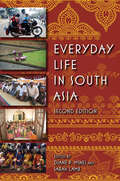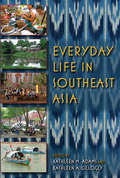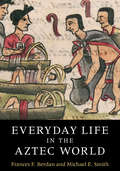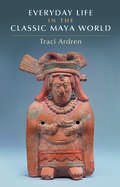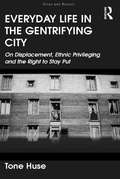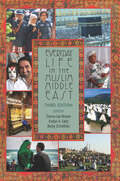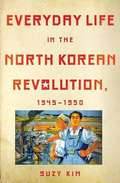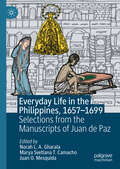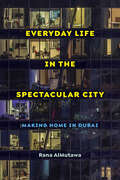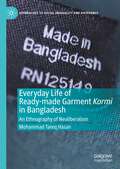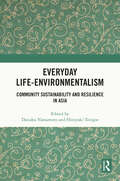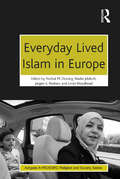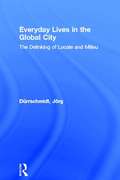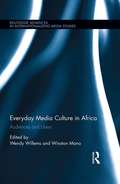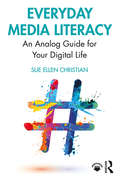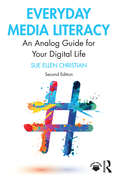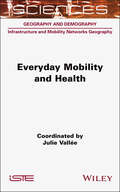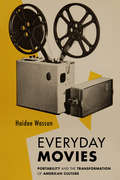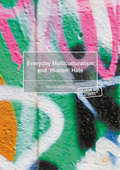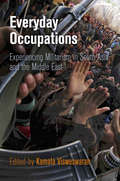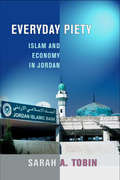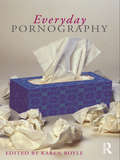- Table View
- List View
Everyday Life in South Asia, Second Edition
by Sarah E. Lamb Diane P. MinesThis anthology provides a lively and stimulating view of the lives of ordinary citizens in India, Pakistan, Bangladesh, Nepal, and Sri Lanka. For the second edition of this popular textbook, readings have been updated and new essays added. The result is a timely collection that explores key themes in understanding the region, including gender, caste, class, religion, globalization, economic liberalization, nationalism, and emerging modernities. New readings focus attention on the experiences of the middle classes, migrant workers, and IT professionals, and on media, consumerism, and youth culture. Clear and engaged writing makes this text particularly valuable for general and student readers, while the range of new and classic scholarship provides a useful resource for specialists.
Everyday Life in Southeast Asia
by Kathleen A. Gillogly Kathleen M. AdamsThis lively survey of the peoples, cultures, and societies of Southeast Asia introduces a region of tremendous geographic, linguistic, historical, and religious diversity. Encompassing both mainland and island countries, these engaging essays describe personhood and identity, family and household organization, nation-states, religion, popular culture and the arts, the legacies of war and recovery, globalization, and the environment. Throughout, the focus is on the daily lives and experiences of ordinary people. Most of the essays are original to this volume, while a few are widely taught classics. All were chosen for their timeliness and interest, and are ideally suited for the classroom.
Everyday Life in the Aztec World
by Michael E. Smith Frances BerdanIn Daily Life of the Aztecs, Frances Berdan and Michael E. Smith offer a view into the lives of real people, doing very human things, in the unique cultural world of Aztec central Mexico. The first section focuses on people from an array of social classes - the emperor, a priest, a feather worker, a merchant, a farmer, and a slave - who interacted in the economic, social and religious realms of the Aztec world. In the second section, the authors examine four important life events where the lives of these and others intersected: the birth and naming of a child, market day, a day at court, and a battle. Through the microscopic views of individual types of lives, and interweaving of those lives into the broader Aztec world, Berdan and Smith recreate everyday life in the final years of the Aztec Empire.
Everyday Life in the Balkans
by David W. MontgomeryEveryday Life in the Balkans gathers the work of leading scholars across disciplines to provide a broad overview of the countries of Albania, Bosnia and Herzegovina, Bulgaria, Croatia, Greece, Kosovo, Macedonia, Romania, Serbia, and Turkey. This region has long been characterized as a place of instability and political turmoil, from World War I, through the Yugoslav Wars, and even today as debate continues over issues such as the influx of refugees or the expansion of the European Union. However, the work gathered here moves beyond the images of war and post-socialist stagnation which dominate Western media coverage of the region to instead focus on the lived experiences of the people in these countries. Contributors consider a wide range of issues including family dynamics, gay rights, war memory, religion, cinema, fashion, and politics. Using clear language and engaging examples, Everyday Life in the Balkans provides the background context necessary for an enlightened conversation about the policies, economics, and culture of the region.
Everyday Life in the Classic Maya World
by Traci ArdrenEveryday Life in the Classic Maya World introduces readers to a range of people who lived during the Classic period (200–800 CE) of Maya civilization. Traci Ardren here reconstructs the individual experiences of Maya people across all social arenas and experiences, including less-studied populations, such as elders, children, and non-gender binary people. Putting people, rather than objects, at the heart of her narrative, she examines the daily activities of a small rural household of farmers and artists, hunting and bee-keeping rituals, and the bustling activities of the urban marketplace. Ardren bases her study on up-to-date and diverse sources and approaches, including archaeology, art history, epigraphy, and ethnography. Her volume reveals the stories of ancient Maya people and also shows the relevance of those stories today. Written in an engaging style, Everyday Life in the Classic Maya World offers readers at all levels a view into the amazing accomplishments of a culture that continues to fascinate.
Everyday Life in the Gentrifying City: On Displacement, Ethnic Privileging and the Right to Stay Put (Cities and Society)
by Tone HuseBased on ethnographic fieldwork conducted in Oslo, Everyday Life in the Gentrifying City offers an examination of gentrification from below, exploring the effects of this process upon city neighbourhoods and those that inhabit them, whether residents, business owners and their customers, or local activists. Engaging with recent debates surrounding immigration and the inclusion of ethnic minorities in the city, the book takes up the question of ethnicity and gentrification. It argues for an urban policy that gives up the preoccupation with policies concerning the residential mix and place transformation in favour of empowering its citizens. A lively and engaging analysis, in which theoretical rigour is illuminated with rich interviews and empirical content in order to shed light on the relationship between gentrification, displacement, and integration, Everyday Life in the Gentrifying City will appeal to scholars and students of sociology, geography, anthropology and urban studies.
Everyday Life in the Muslim Middle East, Third Edition
by Lila Abu-Lughod Dawn Chatty Marcia C. Inhorn Farha Ghannam Jonathan Holt Shannon Sherine Hamdy Jenny White Susan Slyomovics Melani Cammett Ziba Mir-Hosseini Fida J. Adely Kristin V. Monroe Brian Silverstein Walter Armbrust Samer S. Shehata Andrew Gardner Diane Singerman William O. Beeman Quintan Wiktorowicz Robert R. Bianchi Victoria Fontan Christine El Ouardani Momina Zakzouk Anne H. Betteridge Steven Caton Angel Foster Simon Hawkins Natalie K. Jensen Kristina Nelson Yagmur Nuhrat Marcie Patton Erika Friedl Loeffler Brian K. BarberThe substantially revised and updated third edition of Everyday Life in the Muslim Middle East focuses on the experiences of ordinary men, women, and children from the region. Readers will gain a grassroots appreciation of Middle East life, culture, and society that recognizes the impact of wars and uprisings as well as changes to Islamic practice due to advances in technology. The book also explores the influence of social media on politics and labor relations and the changing status of women, family values, marriage, childrearing, gender, and gay rights. This dynamic and imaginative volume continues to provide a rich resource for understanding contemporary Muslim culture in the Middle East.
Everyday Life in the North Korean Revolution, 1945–1950
by Suzy KimDuring the founding of North Korea, competing visions of an ideal modern state proliferated. Independence and democracy were touted by all, but plans for the future of North Korea differed in their ideas about how everyday life should be organized. Daily life came under scrutiny as the primary arena for social change in public and private life. In Everyday Life in the North Korean Revolution, 1945-1950, Kim examines the revolutionary events that shaped people's lives in the development of the Democratic People's Republic of Korea. By shifting the historical focus from the state and the Great Leader to how villagers experienced social revolution, Kim offers new insights into why North Korea insists on setting its own course.Kim's innovative use of documents seized by U.S. military forces during the Korean War and now stored in the National Archives--personnel files, autobiographies, minutes of organizational meetings, educational materials, women's magazines, and court documents--together with oral histories allows her to present the first social history of North Korea during its formative years. In an account that makes clear the leading role of women in these efforts, Kim examines how villagers experienced, understood, and later remembered such events as the first land reform and modern elections in Korea's history, as well as practices in literacy schools, communal halls, mass organizations, and study sessions that transformed daily routine.
Everyday Life in the Philippines, 1657–1699: Selections from the Manuscripts of Juan de Paz
by Norah L. A. Gharala Marya Svetlana T. Camacho Juan O. MesquidaThis book examines the legacy of one of the most influential members of Spanish society in the seventeenth-century Philippines, Dominican scholar Juan de Paz. Using a unique manuscript from the collections of the Archivo de la Universidad de Santo Tomás in Manila, the authors provide a window into the concerns, problems, and entanglements of people of different ethnicities, occupations, and stations in life. Paz’s writings resolving conflicts and weighing in on questions (consultas) have not previously been translated into English. The transcriptions, translations, and editorial introductions collected in this volume therefore make it an invaluable resource for students and scholars interested in the cultural and social history of the Philippines and the Spanish empire.
Everyday Life in the Postmodern World: An Introduction to Cultural Studies (Springer Texts in Social Sciences)
by Arthur Asa BergerThis introductory textbook familiarizes students with ideas of key thinkers and perspectives related to postmodern thought and everyday life. The book is unique in that it offers selections from key passages of works of important thinkers as well as from some of the author's own publications that serve as examples of how to interpret various aspects of culture. The book draws in readers with its engaging and conversational style and use of cases, illustrations and photographs, including fun discussions on everyday life under pandemic restrictions. This is a must read for students taking courses in sociology, cultural anthropology, culture and media studies, linguistics, social philosophy, and for specific courses on postmodernism.
Everyday Life in the Spectacular City: Making Home in Dubai
by Rana AlMutawaEveryday Life in the Spectacular City is a groundbreaking urban ethnography that reveals how middle-class citizens and longtime residents of Dubai interact with the city's so-called superficial spaces to create meaningful social lives. Rana AlMutawa shows that inhabitants adapt themselves to top-down development projects, from big malls to megaprojects. These structures serve residents' evolving social needs, transforming Dubai's spectacular spaces into personally important cultural sites. These practices are significant because they expand our understanding of agency as not only subversive but also adaptive. Through extensive fieldwork, AlMutawa, herself an Emirati native to Dubai, finds a more nuanced story of belonging. This story does not seek to uncover the "real" city that lies beneath the veneer of the spectacle, but rather to demonstrate that social meanings and forms of belonging take place within the spectacle itself. By offering an alternative to the discourse of authenticity and elucidating the dynamics of ambivalent belonging, AlMutawa belies stereotypes that portray Dubai's developments as alienating and inherently disempowering. Everyday Life in the Spectacular City speaks beyond the Middle East to a globalized phenomenon, for Dubai's spectacles are unexceptional in today's changing world.
Everyday Life of Ready-made Garment Kormi in Bangladesh: An Ethnography of Neoliberalism (Approaches to Social Inequality and Difference)
by Mohammad Tareq HasanThis book portrays the scene where corporate international trade agreements, a new neoliberal state regime, and a growing textile market have contributed to the becoming of a new class of Muslim female workers—who labor in Bangladesh’s apparel export factories under conditions of neoliberal capitalism. The garment kormi—often abstracted by the homogenizing category of the “garment worker”—remain lost in the statistics of development and empowerment or contrarily exploitation. Thereby, focusing on the everyday lives of garment kormi, i.e., workers’ stories than on the collective of garment workers as a category, this book at one front highlights the neoliberal structures of difference and inequality, and on the other reflects on the potential of egalitarianism and change in terms of novel ways of comprising and expressing life-worlds. It shows that the values in life and the structures that govern life, such as contemporary Bangladesh’s neoliberal order, kinship relationality, and religiosity, are co-constitutive, multi-layered, and always on the move, never fixed.
Everyday Life-Environmentalism: Community Sustainability and Resilience in Asia
by Daisaku Yamamoto Hiroyuki TorigoeThis book provides one of the first systematic introductions to the Japanese concept of life-environmentalism, Seikatsu-Kankyo Shugi. This concept emerged in the 1980s as a shared research framework among Japanese social scientists studying the adverse consequences of postwar industrialization on everyday life in communities. Life-environmentalism offers a lens through which the agency of small communities in sustaining their everyday life and living environment can be understood. The book provides an overview of this approach, including intellectual backgrounds and foundational concepts, along with a variety of empirical case studies that examine environmental and sustainability issues in Japan and other parts of Asia. It also includes critical reflections on the approach in light of contemporary sustainability challenges. The empirical topics covered in the book include local community responses to development projects, resource governance, disaster response and recovery, and historical environmental preservation. The chapters are contributed by researchers working at the forefront of the field. It provides only a glimpse into the vast literature that awaits further exploration and engagement in the future. The book is suitable for upper undergraduate students, graduate students, and researchers interested in environmental problems, sustainability and resilience, disaster mitigation and response, and regional development in Asian contexts, particularly Japan. It is well-suited for courses in anthropology, geography, sociology, urban and regional planning, political science, Asian studies, and environmental studies.
Everyday Lifestyles and Sustainability: The Environmental Impact Of Doing The Same Things Differently
by Robert Vale Brenda Vale Fabricio ChiccaThe impact of humanity on the earth overshoots the earth’s bio-capacity to supply humanity’s needs, meaning that people are living off earth’s capital rather than its income. However, not all countries are equal and this book explores why apparently similar patterns of daily living can lead to larger and smaller environmental impacts. The contributors describe daily life in many different places in the world and then calculate the environmental impact of these ways of living from the perspective of ecological and carbon footprints. This leads to comparison and discussion of what living within the limits of the planet might mean. Current footprints for countries are derived from national statistics and these hide the variety of impacts made by individual people and the choices they make in their daily lives. This book takes a ‘bottom-up’ approach by calculating the footprints of daily living. The purpose is to show that small changes in behaviour now could avoid some very challenging problems in the future. Offering a global perspective on the question of sustainable living, this book will be of great interest to anyone with a concern for the future, as well as students and researchers in environmental studies, human geography and development studies.
Everyday Lived Islam in Europe (AHRC/ESRC Religion and Society Series)
by Linda Woodhead Nathal M. Dessing Nadia JeldtoftThis book offers a new direction for the study of contemporary Islam by focusing on what being Muslim means in people’s everyday lives. It complements existing studies by focusing not on mosque-going, activist Muslims, but on how people live out their faith in schools, workplaces and homes, and in dealing with problems of health, wellbeing and relationships. As well as offering fresh empirical studies of everyday lived Islam, the book offers a new approach which calls for the study of ’official’ religion and everyday ’tactical’ religion in relation to one another. It discusses what this involves, the methods it requires, and how it relates to existing work in Islamic Studies.
Everyday Lives in the Global City: The Delinking of Locale and Milieu
by Jörg DürrschmidtRejecting simplifying notions of globalisation as a macro-economic force, this book provides a grounded picture of the various ways in which people's biographies are tied up with the global cultural economy. The main argument of the book is that the globalisation of lives is experienced by people as the 'extension' of their 'milieux' both spatially and symbolically.
Everyday Media Culture in Africa: Audiences and Users (Routledge Advances in Internationalizing Media Studies)
by Wendy Willems Winston ManoAfrican audiences and users are rapidly gaining in importance and increasingly targeted by global media companies, social media platforms and mobile phone operators. This is the first edited volume that addresses the everyday lived experiences of Africans in their interaction with different kinds of media: old and new, state and private, elite and popular, global and national, material and virtual. So far, the bulk of academic research on media and communication in Africa has studied media through the lens of media-state relations, thereby adopting liberal democracy as the normative ideal and examining the potential contribution of African media to development and democratization. Focusing instead on everyday media culture in a range of African countries, this volume contributes to the broader project of provincializing and decolonizing audience and internet studies.
Everyday Media Literacy: An Analog Guide for Your Digital Life
by Sue Ellen ChristianIn this graphic guide to media literacy, award-winning educator Sue Ellen Christian offers students an accessible, informed and lively look at how they can consume and create media intentionally and critically. The straight-talking textbook offers timely examples and relevant activities to equip students with the skills and knowledge they need to assess all media, including news and information. Through discussion prompts, writing exercises, key terms, online links and even origami, readers are provided with a framework from which to critically consume and create media in their everyday lives. Chapters examine news literacy, online activism, digital inequality, privacy, social media and identity, global media corporations and beyond, giving readers a nuanced understanding of the key concepts and concerns at the core of media literacy. Concise, creative and curated, this book highlights the cultural, political and economic dynamics of media in our contemporary society, and how consumers can mindfully navigate their daily media use. Everyday Media Literacy is perfect for students (and educators) of media literacy, journalism, education and media effects looking to build their understanding in an engaging way.
Everyday Media Literacy: An Analog Guide for Your Digital Life
by Sue Ellen ChristianIn this second edition, award-winning educator Sue Ellen Christian offers students an accessible and informed guide to how they can consume and create media intentionally and critically. The textbook applies media literacy principles and critical thinking to the key issues facing young adults today, from analyzing and creating media messages to verifying information and understanding online privacy. Through discussion prompts, writing exercises, key terms, and links, readers are provided with a framework from which to critically consume and create media in their everyday lives. This new edition includes updates covering privacy aspects of AI, VR and the metaverse, and a new chapter on digital audiences, gaming, and the creative and often unpaid labor of social media and influencers. Chapters examine news literacy, online activism, digital inequality, social media and identity, and global media corporations, giving readers a nuanced understanding of the key concepts at the core of media literacy. Concise, creative, and curated, this book highlights the cultural, political, and economic dynamics of media in contemporary society, and how consumers can mindfully navigate their daily media use. This textbook is perfect for students and educators of media literacy, journalism, and education looking to build their understanding in an engaging way.
Everyday Mobility and Health (ISTE Consignment)
by Julie ValléeEveryday mobility is neither favorable nor unfavorable to health. While it can facilitate social interactions, increase access to remote services, or encourage physical activity, it can also generate pollution, promote the spread of epidemics or cause traffic accidents. This book presents different facets of the relationship between daily mobility and health, focusing on the environments (geographical, social and political) that people live and move around in. It analyzes the role of mobility in the mechanisms of environmental exposure and diffusion, as well as the resulting health inequalities. It deals with active modes of travel (mainly walking and cycling) and the local contexts that are conducive to them. Finally, it offers a critical reading of the place given to everyday mobility in policies to combat obesity and rationalize regional healthcare provision.
Everyday Movies: Portable Film Projectors and the Transformation of American Culture
by Haidee WassonEveryday Movies documents the twentieth-century rise of portable film projectors. It demonstrates that since World War II, the vast majority of movie-watching did not happen in the glow of the large screen but rather took place alongside the glitches, distortions, and clickety-clack of small machines that transformed home, classroom, museum, community, government, industrial, and military venues into sites of moving-image display. Reorienting the history of cinema away from the magic of the movie theater, Haidee Wasson illustrates the remarkable persistence and proliferation of devices that fundamentally rejected the sleek, highly professionalized film show. She foregrounds instead another kind of apparatus, one that was accessible, affordable, adaptable, easy to use, and crucially, programmable. Revealing rich archival discoveries, this book charts a compelling and original history of film that brings to light new technologies and diverse forms of media engagement that continue to shape contemporary life.
Everyday Multiculturalism and ‘Hidden’ Hate
by Stevie-Jade HardyThis book examines the lived reality of 'everyday multiculturalism', and the ways that young people make sense of the diverse world around them. Currently we know very little about how multiculturalism shapes our lives, our interactions and our identity. This is especially pertinent for young people. How do young people from largely white, disadvantaged backgrounds interpret multiculturalism? How do they engage with people from 'different' minority ethnic and faith communities? How do they negotiate the challenges that arise within ever-diversifying environments? Drawing on empirical research, Stevie-Jade Hardy uncovers the fears and tensions that both undermine, and are caused by, doing multiculturalism. In doing so, she shines a light on the 'hidden' phenomenon of youth hate crime perpetration. This book will be of particular interest to scholars of criminology, sociology and cultural studies, as well as to professionals and policy-makers working in the fields of diversity and hate crime.
Everyday Occupations
by Kamala VisweswaranIn the twenty-first century, political conflict and militarization have come to constitute a global social condition rather than a political exception. Military occupation increasingly informs the politics of both democracies and dictatorships, capitalist and formerly socialist regimes, raising questions about its relationship to sovereignty and the nation-state form. Israel and India are two of the world's most powerful postwar democracies yet have long-standing military occupations. Pakistan, Bangladesh, and Turkey have passed through periods of military dictatorship, but democracy has yielded little for their ethnic minorities who have been incorporated into the electoral process. Sri Lanka and Bangladesh (like India, Pakistan, and Turkey) have felt the imprint of socialism; declarations of peace after long periods of conflict in these countries have not improved the conditions of their minority or indigenous peoples but rather have resulted in "violent peace" and remilitarization. Indeed, the existence of standing troops and ongoing state violence against peoples struggling for self-determination in these regions suggests the expanding and everyday nature of military occupation. Such everydayness raises larger issues about the dominant place of the military in society and the social values surrounding militarism.Everyday Occupations examines militarization from the standpoints of both occupier and occupied. With attention to gender, poetics, satire, and popular culture, contributors who have lived and worked in occupied areas in the Middle East and South Asia explore what kinds of society are foreclosed or made possible by militarism. The outcome is a powerful contribution to the ethnography of political violence.Contributors: Nosheen Ali, Kabita Chakma, Richard Falk, Sandya Hewamanne, Mohamad Junaid, Rhoda Kanaaneh, Hisyar Ozsoy, Cheran Rudhramoorthy, Serap Ruken Sengul, Kamala Visweswaran.
Everyday Piety: Islam and Economy in Jordan
by Sarah A. TobinWorking and living as an authentic Muslim--comporting oneself in an Islamically appropriate way--in the global economy can be very challenging. How do middle-class Muslims living in the Middle East navigate contemporary economic demands in a distinctly Islamic way? What are the impacts of these efforts on their Islamic piety? To what authority does one turn when questions arise? What happens when the answers vary and there is little or no consensus? To answer these questions, Everyday Piety examines the intersection of globalization and Islamic religious life in the city of Amman, Jordan. Drawing on in-depth ethnographic fieldwork in Amman, Sarah A. Tobin demonstrates that Muslims combine their interests in exerting a visible Islam with the opportunities and challenges of advanced capitalism in an urban setting, which ultimately results in the cultivation of a "neoliberal Islamic piety." Neoliberal piety, Tobin contends, is created by both Islamizing economic practices and economizing Islamic piety, and is done in ways that reflect a modern, cosmopolitan style and aesthetic, revealing a keen interest in displays of authenticity on the part of the actors. Tobin highlights sites at which economic life and Islamic virtue intersect: Ramadan, the hijab, Islamic economics, Islamic banking, and consumption. Each case reflects the shift from conditions and contexts of highly regulated and legalized moral behaviors to greater levels of uncertainty and indeterminacy. In its ethnographic richness, this book shows that actors make normative claims of an authentic, real Islam in economic practice and measure them against standards that derive from Islamic law, other sources of knowledge, and the pragmatics of everyday life.
Everyday Pornography
by Karen BoylePublic and academic debate about ‘porn culture’ is proliferating. Ironically, what is often lost in these debates is a sense of what is specific about pornography. By focusing on pornography’s mainstream – contemporary commercial products for a heterosexual male audience – Everyday Pornography offers the opportunity to reconsider what it is that makes pornography a specific form of industrial practice and genre of representation. Everyday Pornography presents original work from scholars from a range of academic disciplines (Media Studies, Law, Sociology, Psychology, Women’s Studies, Political Science), introducing new methodologies and approaches whilst reflecting on the ongoing value of older approaches. Among the topics explored are: the porn industry’s marketing practices (spam emails, reviews) and online organisation commercial sex in Second Life the pornographic narratives of phone sex and amateur videos the content of best-selling porn videos how the male consumer is addressed by pornography, represented within the mainstream, understood by academics and contained by legislation. This collection places a particular emphasis on anti-pornography feminism, a movement which has been experiencing a revival since the mid-2000s. Drawing on the experiences of activists alongside academics, Everyday Pornography offers an opportunity to explore the intellectual and political challenges of anti-pornography feminism and consider its relevance for contemporary academic debate.
